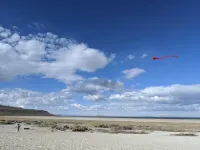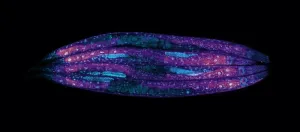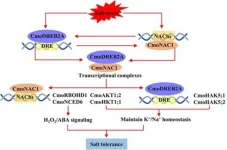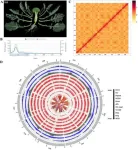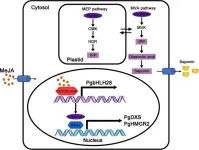(Press-News.org) Inland seas around the world are drying up due to increasing human water use and accelerating climate change, and their desiccation is releasing harmful dust that pollutes the surrounding areas during acute dust storms. Using the Great Salt Lake in Utah as a case study, researchers show that dust exposure was highest among Pacific Islanders and Hispanic people and lower in white people compared to all other racial/ethnic groups, and higher for individuals without a high school diploma. Restoring the lake would benefit everyone in the vicinity by reducing dust exposure, and it would also decrease the disparities in exposure between different racial/ethnic and socioeconomic groups. These results are reported June 21 in the journal One Earth.
“People here in Utah are concerned about the lake for a variety of reasons—the ski industry, the brine shrimp, the migratory birds, recreation—and this study adds environmental justice and the equity implications of the drying lake to the conversation,” says first author and sociologist Sara Grineski of the University of Utah. “If we can raise the levels of the lake via some coordinated policy responses, we can reduce our exposure to dust, which is good for everyone's health, and we can also reduce the disparity between groups.”
The Great Salt Lake has been steadily drying since the mid-1980’s, exposing its dry lakebed to atmospheric weathering and wind. Previous studies have shown that dust emissions from drying salt lakes produce fine particulate matter (PM2.5), which is associated with numerous health effects and is the leading environmental cause of human mortality worldwide.
“We know that the dust from these drying lakes is very unhealthy for us, so the question becomes, what does that mean in terms of people's exposure to the dust, and what does it mean in terms of inequalities in exposure to that dust,” says Grineski. “Are some people more likely to have to suffer the consequences to a greater degree?”
To answer this question, Grineski teamed up with a multidisciplinary group including atmospheric scientists, geographers, and biologists. They started by using a model to investigate how dust pollution would change if the lake became even dryer, or if its levels rose to a healthy level. The model simulated how much dust would be created by erosion under different lake-level scenarios and how wind would distribute this dust in three counties surrounding the Great Salt Lake. Then, the team combined the model’s outputs with demographic data from the 2020 U.S. Decennial Census and American Community Survey to examine whether the severity of dust exposure is associated with racial/ethnic groups or socioeconomic status.
During a typical dust storm, the team found that at the lake’s current level, people in the Great Salt Valley are exposed to 26 μg/m3 of dust PM2.5 on average, which is higher than the World Health Organization’s threshold of 15 μg/m3 (though lower than the less stringent U.S. National Ambient Air Quality Standards threshold of 35 μg/m3). If the lake were to dry up completely, average exposure during dust storms would increase to 32 μg/m3, but restoring the lake to a healthy level would decrease the average exposure to 24 μg/m3.
They also showed that some groups within the population are exposed to disproportionate levels of dust. Exposure was highest in Pacific Islanders and Hispanic people, and higher in people without a high school diploma (one metric of socioeconomic status), though there was no association between the risk of dust exposure and income level or home ownership.
Raising the lake’s level would decrease the disparities between groups, thus helping to alleviate one form of environmental injustice within the region, though Grineski notes that the valley is home to other social disparities in pollution exposure.
“If the lake’s level rises, the dust drops, and the disparity in exposure narrows for race/ethnicity and education,” says Grineski.
In the future, the team would like to investigate how potential future changes to the region’s population size and shape might influence who is most exposed to dust from the lake. Ultimately, they hope their results will help guide local policy makers to prioritize re-filling the Great Salt Lake.
“If we were to enact policy and conservation measures to raise the lake, we would benefit not only in terms of decreased dust, but in terms of less dramatic disparities between who is breathing in more of this dust,” says Grineski. “It’s important to consider the environmental justice implications of different choices that we might make in the policy arena when we think about different strategies for adaptation and mitigation to climate change.”
###
This research was supported by the National Science Foundation.
One Earth, Grineski et al. “Harmful dust from drying lakes: Preserving Great Salt Lake (USA) water levels decreases ambient dust and racial disparities in population exposure” https://www.cell.com/one-earth/fulltext/S2590-3322(24)00249-5
One Earth (@OneEarth_CP), published by Cell Press, is a monthly journal that features papers from the fields of natural, social, and applied sciences. One Earth is the home for high-quality research that seeks to understand and address today’s environmental Grand Challenges, publishing across the spectrum of environmental change and sustainability science. A sister journal to Cell, Chem, and Joule, One Earth aspires to break down barriers between disciplines and stimulate the cross-pollination of ideas with a platform that unites communities, fosters dialogue, and encourages transformative research. Visit http://www.cell.com/one-earth. To receive Cell Press media alerts, contact press@cell.com.
END
About The Study: The findings of this cohort study suggest that cannabis use may be an independent risk factor for COVID-19–related complications, even after considering cigarette smoking, vaccination status, comorbidities, and other risk factors.
Corresponding Author: To contact the corresponding author, Li-Shiun Chen, M.D., M.P.H., Sc.D., email li-shiun@wustl.edu.
To access the embargoed study: Visit our For The Media website at this link https://media.jamanetwork.com/
(doi:10.1001/jamanetworkopen.2024.17977)
Editor’s ...
About The Study: This randomized clinical trial of Chinese adults with overweight or obesity and with early type 2 diabetes found that an intermittent fasting plan consisting of two nonconsecutive fasting days and five days of habitual intake per week and meal replacement diet (5:2 MR) could improve glycemic outcomes and weight loss in the short term compared with metformin or empagliflozin, making it a promising initial intervention and early management for type 2 diabetes.
Corresponding Author: To contact the corresponding author, Lixin Guo, M.D., email glx1218@163.com.
To access the embargoed study: Visit ...
Scientists from the University of Copenhagen have made significant strides in understanding ancient ocean anoxia, with potential insights for today's marine environments.
500 million years ago the so-called Cambrian ‘SPICE’ event made oxygen levels in the oceans drop dramatically.
Now, researchers from the University of Copenhagen have investigated how large-scale ocean anoxia, or oxygen-depleted conditions, developed during the event, and its potential consequences today.
In the study, titled "Cascading oxygen loss shorewards in the oceans – insights from the Cambrian SPICE event" published in OneEarth ...
HOUSTON ― Researchers at The University of Texas MD Anderson Cancer Center have demonstrated that therapeutically restoring ‘youthful’ levels of a specific subunit of the telomerase enzyme can significantly reduce the signs and symptoms of aging in preclinical models. If these findings are confirmed in clinical studies, there may be therapeutic implications for age-related diseases such as Alzheimer’s, Parkinson’s, heart disease and cancer.
The study, published today in Cell, identified a small molecule compound ...
As the deadly disease that came to be known as COVID-19 started spreading in late 2019, scientists rushed to answer a critical question: Who is most at risk?
They quickly recognized that a handful of characteristics — including age, smoking history, high body mass index (BMI) and the presence of other diseases such as diabetes — made people infected with the virus much more likely to become seriously ill and even die. But one suggested risk factor remains unconfirmed more than four years later: cannabis use. Evidence has emerged over time indicating both ...
Why do some people live for longer than others? The genes in our DNA sequence are important, helping avoid disease or maintain general health, but differences in our genome sequence alone explain less than 30% of the natural variance of human life expectancy.
Exploring how ageing is influenced at the molecular level could shed light on lifespan variation, but generating data at the speed, scale and quality necessary to study this in humans is unfeasible. Instead, researchers turn to worms (Caenorhabditis elegans). Humans share a lot of biology with these small creatures, who also have a large, natural variation in lifespan.
Researchers ...
Small changes in our everyday actions can trigger significant, rapid societal shifts especially when it comes to climate action. A new IIASA-led study highlights the importance of analyzing these dynamics with a comprehensive framework to harness their full potential for reducing carbon emissions.
Making small changes in how we live day-to-day can quickly create significant changes in society, especially in ways that benefit the environment. This idea is captured in the term social tipping points.
According to the authors of a new paper just published in the journal One Earth, social tipping points are crucial for speeding up efforts to reduce carbon emissions. These points occur when ...
A pivotal study has discovered a genetic synergy between pumpkin and cucumber that fortifies the latter's resilience against salinity. The research illuminates the role of the CmoDREB2A transcription factor from pumpkin, which, when interacted with cucumber's CmoNAC1, forms a regulatory loop that enhances salt tolerance. This breakthrough could be key to developing crops that thrive in saline soils, safeguarding agricultural productivity.
Soil salinity, a silent blight on global agriculture, affects an estimated 10% of the world's arable land, leading to significant crop ...
A detailed genomic study of broccoli has revealed the genetic foundations for the production of glucosinolates (GSLs), compounds celebrated for their health benefits, including anti-carcinogenic properties. By assembling a high-quality chromosome-level genome, researchers identified key genes involved in GSL biosynthesis. These findings offer critical insights for future genetic studies and the development of Brassica crops with enhanced nutritional value, paving the way for improved health benefits from these widely consumed vegetables.
Broccoli is renowned for its health benefits, primarily due to its rich glucosinolate (GSL) content, which has anti-carcinogenic ...
A cutting-edge study has pinpointed the PgbHLH28 gene as a crucial catalyst in the methyl jasmonate-induced (MeJA-induced) saponin biosynthesis in Platycodon grandiflorus. This genetic insight could significantly bolster the production of saponins, which are beneficial in combating cerebrovascular diseases and COVID-19, offering a novel therapeutic avenue in medicinal plant cultivation.
Platycodon grandiflorus, commonly known as balloon flower, is renowned for its medicinal properties, primarily due to its rich saponin content. Saponins are known for ...
